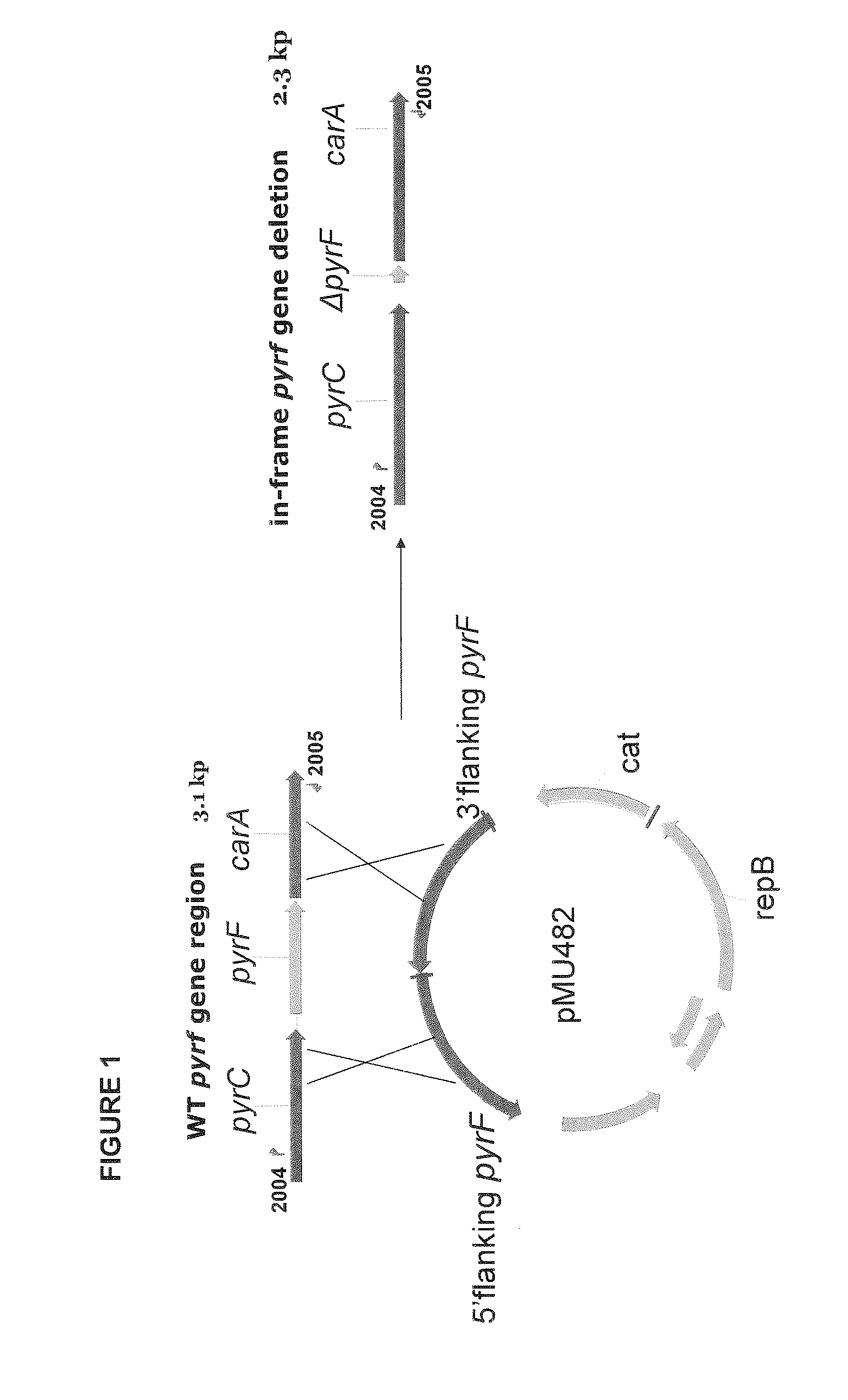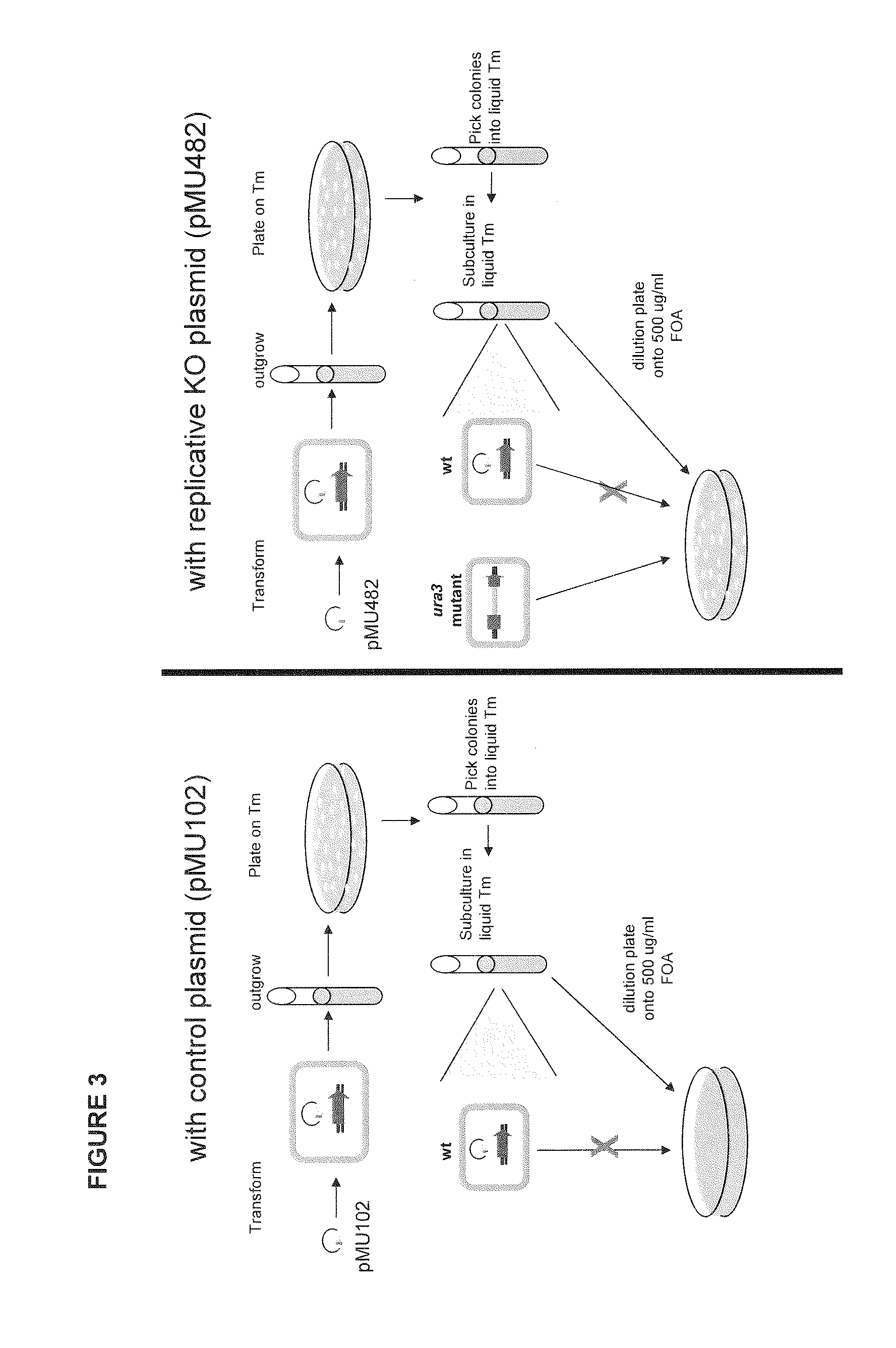Positive and negative selectable markers for use in thermophilic organisms
- Summary
- Abstract
- Description
- Claims
- Application Information
AI Technical Summary
Benefits of technology
Problems solved by technology
Method used
Image
Examples
example 1
Positive and Negative Selection Using a C. thermocellum pyrF Knockout
[0148]Homologous recombination was utilized to make an in-frame deletion of the pyrF gene. A depiction of the expected recombination events and the resulting pyrF deletion is shown in FIG. 1. To knockout the pyrF gene, a replicative knockout vector was constructed which contained sequences homologous to upstream and downstream sequences of the pyrF gene. The created plasmid is referred to as pMU482. The control plasmid, pMU102, does not contain sequences homologous to upstream or downstream sequences of the pyrF gene. The pMU482 and pMU102 plasmids are depicted in FIG. 2.
Creation of C. thermocellum pyrF Deletion
[0149]Plasmid pMU482 was transformed into the wild type C. thermocellum strain 1313 and selected on a rich media containing thyamphenicol (at the concentration of 6 μg / ml) to select for cells containing the cat marker encoded on the plasmid. A schematic displaying the creation of the knockout vector is depic...
example 2
Positive and Negative Selection in Targeted Gene Deletions of C. thermocellum Using pyrF
[0155]The ability of pyrF to be utilized as a positive and negative selection marker in C. thermocellum led to the utilization of this marker for the creation of strains with a targeted gene deletion. One such target gene phosphotransacetylase (pta) is involved in the conversion of acetyl-CoA to acetate. The production of a modified organism harboring a pta deletion would be advantageous since it would prevent acetate production, thereby channeling the carbon flux towards increased ethanol production. Deletion of pta would facilitate the ultimate goal of making a homoethanologen strain (in conjunction with the deletion of other byproduct pathway genes such as ldh).
[0156]To knockout the pta gene, a knockout vector, pMU1162, was constructed which contained sequences homologous to upstream and downstream sequences of the pta gene with a chloramphenicol acetyltrasnferase (cat) gene located between th...
example 3
Negative Selection Utilizing tdk Creation of a C. thermocellum Strain Containing T. saccharolyticum tdk
[0159]To stably express the T. saccharolyticum tdk gene in C. thermocellum, allelic replacement using pyrF was performed. Plasmid pMU1452, as depicted in FIG. 16, was designed to replace the native C. thermocellum pyrF gene with the T. saccharolyticum tdk gene. The resulting strain is designated pyrF::tdk. The pyrF locus was chosen as the site for allelic replacement because the antimetabolite 5-FOA can be used to select for loss of the pyrF gene, as discussed above. The sequence of pMU1452 corresponds to SEQ ID NO: 4. The strategy used to generate the tdk strain and the results of PCR screening are shown in FIG. 17. PCR screening of colonies A and B demonstrates that the pyrF gene was successfully replaced with tdk.
Negative Selection Using tdk
[0160]C. thermocellum strains carrying the T. saccharolyticum tdk gene should be sensitive to fluorodeoxyuridine (FUDR) whereas those that d...
PUM
| Property | Measurement | Unit |
|---|---|---|
| Nucleic acid sequence | aaaaa | aaaaa |
Abstract
Description
Claims
Application Information
 Login to View More
Login to View More - R&D
- Intellectual Property
- Life Sciences
- Materials
- Tech Scout
- Unparalleled Data Quality
- Higher Quality Content
- 60% Fewer Hallucinations
Browse by: Latest US Patents, China's latest patents, Technical Efficacy Thesaurus, Application Domain, Technology Topic, Popular Technical Reports.
© 2025 PatSnap. All rights reserved.Legal|Privacy policy|Modern Slavery Act Transparency Statement|Sitemap|About US| Contact US: help@patsnap.com



